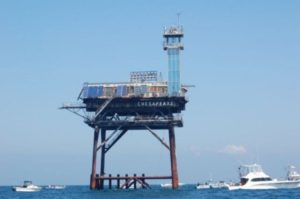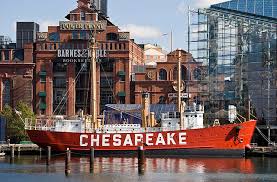The Chesapeake Light Tower is is a key navigational aid to maritime vessels as they approach the Chesapeake Bay. This historical tower is located approximately 13 miles off the shores of Virginia Beach, Virginia. It was completed in 1965.
The tower itself is actually situated among acres of scattered wreckage and manmade reefs. In effect, the Chesapeake Light stands as “king” over its expansive graveyard of sunken barges, box cars, tires, tug boats, and entangled masses of steel. To the delight of anglers, this submerged array of structure provides a perfect kingdom for a community of different fish species, including black sea bass, flounder, tautog, triggerfish, king mackerel, Spanish mackerel, and even super-sized cobia.
The tower provides data collection for various scientific research projects, as well as sea and weather conditions as an integral link to the NOAA marine reporting system. The tower was originally manned by a team of four before it was converted into an automated station. It was patterned after the “Texas-style” oil drilling platforms and is extremely sturdy. Chesapeake Light is supported by four concrete-filled steel legs buried 180 feet within the ocean floor, designed to withstand the violent sea conditions frequently presented by the treacherous mid-Atlantic waters.
The tower itself is actually situated among acres of scattered wreckage and manmade reefs. In effect, the Chesapeake Light stands as “king” over its expansive graveyard of sunken barges, box cars, tires, tug boats, and entangled masses of steel. To the delight of anglers, this submerged array of structure provides a perfect kingdom for a community of different fish species, including black sea bass, flounder, tautog, triggerfish, king mackerel, Spanish mackerel,tuna, and even super-sized cobia. It is also a destination for those that enjoy free diving, spear fishing, and scuba diving.
So how did maritime vessels navigate prior to the Chesapeake Light Tower? In 1933 the US Lighthouse Service assigned Lightships. The responsibility of a seagoing lightship station was to act as the navigational aid at the entrance of the bay. Lightship Chesapeake sported a bright red hull, adorned with the word “Chesapeake” in huge white letters. The all-steel constructed 133 foot lightship was exceptionally seaworthy, enabling the ship to remain on station during the most adverse of weather conditions. She even weathered three full-strength hurricanes! Eventually the lightship was reassigned to guide traffic into the Delaware Bay and retired. You can visit her new home as a floating museum in Baltimore’s Inner Harbor.


